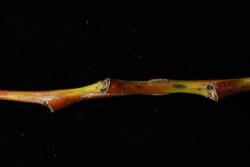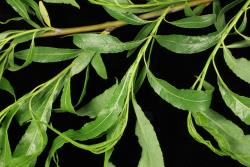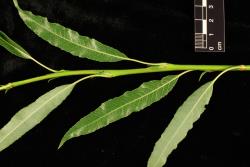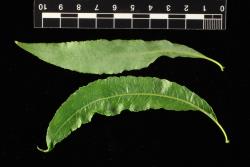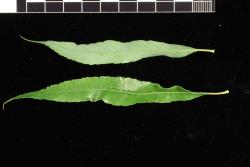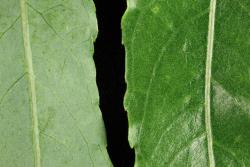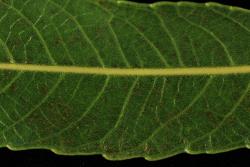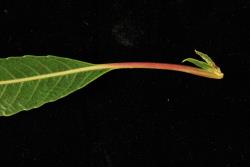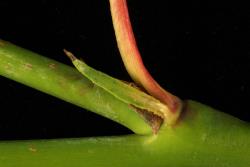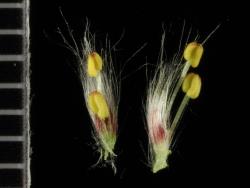- ≡ Salix daphnoides subsp. acutifolia (Willd.) Ahlfv. in Neuman & Ahlfvengren, Sver. Fl. 612 (1901)
Multi-branched shrubs to 6 m. Branchlet wood without ridges but with small, sharp projections. Current year's branchlets glabrous, yellow-green (UCL117) with a white, waxy bloom. Year-old branchlets dark red with a white, waxy bloom, glabrous, 2.6–3.5 mm diameter. Flower bud scale 14–16 mm long, 3.5–4.5 mm in diameter, cylindrical-ovate, keels absent, with densely short-silky hairs, the hairs not persisting, red-brown (UCL43). Leaves alternate. Stipule persistent, 10–17 mm long, very narrowly ovate. Petiole 10–25 mm long, glabrous to moderately densely tomentose, glands absent, base expanded, red or pinky red. Emerging leaves green, with sparse short-silky hairs. Proximal leaves toothed. Leaf lamina 108–142 mm long, 16–30 mm wide, length to width ratio 5.7–7.5:1, very narrowly elliptical to very narrowly ovate, not falcate; base cuneate; apex very narrowly acute to very narrowly acuminate; leaf galls absent; orange rust absent in late summer; margins moderately densely serrulate, undulate; upper lamina surface smooth, midvein raised, very glossy, glabrous, stomata sparse (sometimes denser near midvein); lower lamina surface midvein raised, indistinctly glaucous (rubbed off), glabrous. Catkins precocious, coetaneous, or serotinous. Flowering branch 31–50 mm long with 2–4 cataphylls. Male catkin 37–38 mm long, 11–19 mm diameter; catkin rachis not visible between flowers. Flower bract 1.8–2.2 mm long, ca. 0.5 mm wide, turning crimson then becoming black distally, the whole bract eventually black, flat; apex acute; dense long-silky hairs all over. Male nectaries 1(2), 0.4–0.9 mm long, 0.2–0.3 mm wide, a flattened cylinder, green turning yellow. Stamens 2, filaments free, filament hairs absent; anthers 1.0–1.4 mm long, yellow or slightly red tinged.
One-year-old branchlets pruinose (with a whitish waxy coating), appearing very pale violet in winter, hence the name violet willow. New green branchlets are glabrous. Branchlets have obvious buttresses below the buds. Flower bud scales are narrowly ovoid with a short beak, membranous with branching veins visible in the membrane. Leaves are very narrowly elliptical, very narrowly acuminate at the apex, glabrous, the upper surface glossy, the lower surface glaucous. Stomata on the upper leaf surface are sparse. Mature leaves are glabrous but very new bud leaves may have sparse, silky hairs on the upper surface, or the hairs may be confined to the petiole upper surface. Catkins are sessile or on a very short branch, with a few cataphylls below the catkin. Male catkins have long-silky hairs on the bracts obscuring the flowers; the bracts are crimson when young, initially bicoloured but eventually completely black. The anthers are yellow or slightly red-tinged before dehiscence. One of only 5 species of subgenus Vetrix in New Zealand that can have 2 male nectaries, the others being Salix magnifica, S. melanopsis, S. triandra, and S. viminalis.
Similar to Salix daphnoides, and formerly considered to be S. daphnoides ssp. acutifolia (e.g., Sykes 1988). Meikle (1984) and Skvortsov (1999) recognised S. acutifolia as a species. Skvortsov commented that they do not overlap in their native distribution. Both have a waxy bloom on 1-year-old branchlets. Salix acutifolia has young green branchlets that are glabrous, not hairy, and juvenile leaves that are glabrous, not sparsely tomentose. One-year-old branchlets are 2.6–3.5 mm in diameter; in S. daphnoides they are generally thicker, 3.0–4.5 mm in diameter. The petiole of S. acutifolia is not expanded at the base but is enlarged in S. daphnoides and is sometimes bright red. Leaves of S. acutifolia are narrower, 16–30 mm wide, not 23–39 mm wide. Flower bud scales in S. acutifolia are 14–16 mm long, but only 7–12 mm long in S. daphnoides .
In cultivation in Christchurch (1962, 1968, 1980, 2016) and North Canterbury Catchment Board Waimakariri nursery (1964–1965).
Based on a single wild record at Waioeka Gorge (1976).
First collection: CHR 368455, M. Heginbotham, January 1976, Waioeka Gorge, "roadside near river". A Ministry of Works planting was present in the gorge at the time and the specimen does not explicitly state that the plant was wild.
First publication: Sykes 1982 as Salix daphnoides subsp. acutifolia.
Flowering: Early September–mid-November.
Diploid, 2n = 38 (CCDB based on five counts) and provisionally confirmed by flow cytometry using PN331 and PN678 from Aokautere.



